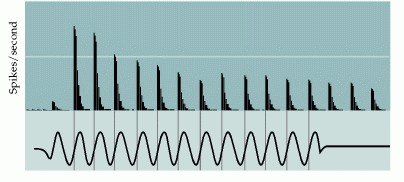Sure, a small problem is that some people have extraordinary hearing capabilities often based on self-proclamation.
Actually Pavel, I thought your hearing was quite exceptionally good.
As to the do we actually listen to our designs line... In my systems there is usually a symmetry in the loudspeaker coverage area, so half of it is not really well reviewed. Then there is the wavelength issue being such that a few inches can actually make a differences in high frequency perception.
So quite simply I never have really listened to all of the sound field for one of my systems. To just do a quick listen in 5% of the seats takes about a week.
I did miss a problem in my last project. Easily fixed once noticed. But I do have to admit I am having a bit more difficulty climbing the 250 typical steps to get to the top seats. (And I often wonder how the fat folks often sit there!)
ES
Actually Pavel, I thought your hearing was quite exceptionally good.
I do not have that high opinion on my hearing
There were several experiments in the 1970s and 1980s exploring the audibility of phase distortions and absolute polarity and it was discovered that the ear works in a asymmetrical way or more precisely responds differently in different frequency regions.
In the lower frequency region the ear seems to have a half-wave rectifier mechanism which means that hair cells respond to the positive cycle but not during the negative cycle. Therefore the conclusion that on asymmetrical waveforms the effect of polarity reversal is quite obvious.
Unfortunately i have to search for specific papers, so it might take some time.
yes, similar remembrance but I am not going to bother myself to spend time finding it for some one else. It was a couple centuries ago I read about it. One reads and reads and remembers and moves on.
THx-RNMarsh
we have been discussing this a while now
KlausR. Audio Asylum Thread PrinterThere were several experiments in the 1970s and 1980s exploring the audibility of phase distortions and absolute polarity and it was discovered that the ear works in a asymmetrical way or more precisely responds differently in different frequency regions.
In the lower frequency region the ear seems to have a half-wave rectifier mechanism which means that hair cells respond to the positive cycle but not during the negative cycle. Therefore the conclusion that on asymmetrical waveforms the effect of polarity reversal is quite obvious.
Unfortunately i have to search for specific papers, so it might take some time.
There is actually not much in AES and ASA. In a nutshell, polarity inversion is audible, yes, with selected signals, but overall not excessively important.
Below a list of papers and articles I have in my archive. If interested, mail me for a copy.
Klaus
Craig et al., “Effect of Phase on the Quality of a Two-Component Tone”, J. of the Acoustical Society of America 1962, p.1752
Greiner et al., “Observations on the Audibility of Acoustic Polarity”, J. of the Audio Engineering Society 1994, p.245; Comments, JAES 1995, p.147
“While polarity inversion is not easily heard with normal complex musical program material, as our large-scale listening tests showed, it is audible in many select and simplified musical settings. Thus it would seem sensible to keep track of polarity and to play the signal back with the correct polarity to ensure the most accurate reproduction of the original acoustic waveform.”
Greiner et al., “A quest for the audibility of polarity”, Audio Magazine, Dec. 1993, p.40
Heyser, “Polarity convention”, Audio Magazine, Sept. 1979, p.18
Hilliard, “Notes on How Phase and Delay Distortions Affect the Quality of Speech, Music and Sound Effects”, IEEE Transactions on Audio, March-April 1964, p.23
Johnsen, “Proofs of an Absolute Polarity”, Audio Engineering Society paper 3169 (1991)
Knight, “Report of an Ad hoc meeting on the formation of an AES technical committee on audio polarity”, JAES 1981, p.528
Lipshitz et al., “On the Audibility of Midrange Phase Distortion in Audio Systems”, JAES 1982, p.580; Comments, JAES 1983, p.447
“The important point is that there is a well-established mechanism in the inner ear for detecting waveform asymmetries and hence polarity reversal of asymmetric signals. What is perhaps surprising is how subtle this effect generally appears to be on music and speech. As the above-mentioned experiment [13] indicates however, it is an audible factor, and should be taken into account when performing comparisons of audio components [15], [19], [20] -- acoustic polarity should be maintained.”
Long, “Polarity in absolute terms”, Audio Magazine, Aug. 1989, p.14 [about Clark Johnsen’s book “The Wood effect”]
Long, “Upside down – Find out whether you can hear polarity inversion ”, Audio Magazine, July 1996, p.35
... a really popular misapprehension among recording engineers - seems like "we don't pay attention to it therefore no one can hear it" backwards logic or rationalization
the basic physiology of hearing encodes absolute phase/polarity for input below a few kHz - maybe not in the old textbooks some learned from but it is textbook knowledge today
try auditory nerve fiber phase locking in search
Tuning and Timing in the Auditory Nerve - Neuroscience - NCBI BookshelfThe other prominent feature of hair cells—their ability to follow the waveform of low-frequency sounds—is also important in other more subtle aspects of auditory coding. As mentioned earlier, hair cells have biphasic response properties. Because hair cells release transmitter only when depolarized, auditory nerve fibers fire only during the positive phases of low-frequency sounds (Figure 13.10). The resultant “phase locking” that results provides temporal information from the two ears to neural centers that compare interaural time differences. The evaluation of interaural time differences provides a critical cue for sound localization, by means of which a person is able to perceive auditory “space.” That auditory space can be perceived in this way is especially remarkable, given that the cochlea, unlike the retina, cannot represent space directly.

10 Temporal response patterns of a low-frequency axon in the auditory nerve. The stimulus waveform is indicated beneath the histograms, which show the phase-locked responses to a 50-ms tone pulse of 260 Hz. Note that the spikes are all timed to the same phase of the sinusoidal stimulus. (After Kiang, 1984.)
and careful researchers in audio have explored and found evidence in listening tests for much longer
AES E-Library On the Audibility of Midrange Phase Distortion in Audio Systems
Authors: Lipshitz, Stanley P.; Pocock, Mark; Vanderkooy, John
Affiliation: University of Waterloo, Waterloo, Ontario, Canada N2L 3Gl
JAES Volume 30 Issue 9 pp. 580-595; September 1982
Publication Date:September 1, 1982
some might find it interesting that even harmonics giving rise to waveform asymmetry allows for easier detection of relative phase shift between the fundamental and the harmonics
Of course that leads to no new research can contradict what went before, a common attitude here.One reads and reads and remembers and moves on.
The tendency is related to personality type. Superforecaster personalities have been studied a lot and it turns out they have very little need for certainty and having facts be settled. Rather than see things as facts, psychometric testing indicates they tend to see things in terms probabilities and confidence levels that they are constantly updating as new information comes in. Doesn't seem to bother them than nothing is certain, though. A few people are also well over at the other end of the spectrum in that regard. And of course, most people are somewhere in the middle.
I'm with Richard on this. We both have been active in learning about what is important in audio reproduction for many decades, and this absolute polarity question has been addressed, at least enough to show cause for some sensitivity to it, in the 70's and 80's. Then some 'researcher' comes in in the 2000's and decides that nothing is audible except what he 'researches', disregarding past work that to me is just as valid as it was when it was first introduced. For the record, Richard Heyser, and several others of us, fought through the monoaural phase debates with Klipsch in the 1960's, and absolute polarity in the 70's. If you don't believe that absolute polarity is important for 'you' , either because you are lazy or it just doesn't matter enough, so be it, but why challenge past research with limited 'research' to the contrary?
I do not have that high opinion on my hearing, I think it is just normal, maybe a bit trained. And I am sure you knew what I meant
.
No need to be modest. Your designs sound quite good and that comes from more than watching the meter. Or I could be wrong! BIDTS.
Hi Mark,
For sure I left out a lot of things. You can get to the results without the best (or equivalent) of equipment. It's just easier when your variables are fewer.
There is definitely a case for people not to disclose everything. For various reasons, but you can only go on what you read.
-Chris
For sure I left out a lot of things. You can get to the results without the best (or equivalent) of equipment. It's just easier when your variables are fewer.
There is definitely a case for people not to disclose everything. For various reasons, but you can only go on what you read.
-Chris
Thanks. I will make no comment about the moderation, fight club second rule. ;-)Then, welcome! You have however landed in the one area of the site where moderation is very lightly done and tempers / feelings can get pretty frayed multiple times.
Craftwoman should-be more correct ?Careful, we have both male and female members
How can one think to have a "superior listening skill" (see attached) when we cannot even imagine how others hear....Anyone who claims to have superior listening skills with some backup is then pushed forward as "proof" that what they are hearing is true no matter what measured performance reveals.
Experience (what you tell backup ?) is an other thing. It is easy to recognize a familiar face in the crowd.
For me, it is very simple: Or a difference is obvious, and I do take care of it, or i have to concentrate a lot to believe there is a difference: I don't take care. In between ? Excuse-me my phone is ringing, lets talk about it in one week after hours of easy listening.
I have measuring instruments. You cannot avoid them when you design or work on electronic. With age and experience, I think every professional use them less and less. Anyway, who knows what some can hear or not, when it is about distortions, microdynamic , mask effects etc.
About snake oil ? When something violate the known laws of physics, we can be sure. If not, the easy way ? Just try, believing nothing and asking ourself a question: is that the expected profit is worth the money ? ;-)
We are not talking here about instrumentation equipment, it is audio. Like movies. Cheating with the reality the best we can to get the highest pleasure we can. Illusion. God (if any) has never produced a record and my listening room is smaller than the Carnegie Hall. Am-I such a crazy -how do-you call them ? - subjectivist ?
Anyway, no need to fight, it is just to listen to music, a question of taste, no religion.
Yours sincerely,
Tryphon.
Attachments
If you reverse "absolute" phase in your own system, did-you feel a difference or not ? (Need to test more than one record.)Of course that leads to no new research can contradict what went before, a common attitude here.
Looks to me as a good start of a new research.
When we were searching for the Red Rackam's treasure with the captain Haddock... but this is an other story.
Tryphon.
Last edited:
I have measuring instruments. You cannot avoid them when you design or work on electronic. With age and experience, I think every professional use them less and less.
Correct, with age and experience we will also be able to hear the gravitational waves and smell the Higgs bosons.
Correct, with age and experience we will also be able to hear the gravitational waves and smell the Higgs bosons.
Surely for the real oldies a wet finger works for the gravitation waves
I don't know those two albums. Who are the interprets ?Correct, with age and experience we will also be able to hear the gravitational waves and smell the Higgs bosons.
I have read your works here.
Dr. J. W. Müller, you are unmasked.
But you can sleep quiet, no current feedback amplifiers around at this time.
Attachments
Last edited:
OK, so we are talking below 1kHz for absolute phase with biggest effect below 300Hz? Or just into the modal region of the average listening space*? That zone where all bets start to be off. So for mere mortals still not an issue.
Those with personal auditoria and JBL-M2 look like they are in a good place to take advantage of this. The rest of us it's headphones only and probably a resounding 'meh' for us cloth ears.
*Ed does not have these problems. He swapped them for other problems
Those with personal auditoria and JBL-M2 look like they are in a good place to take advantage of this. The rest of us it's headphones only and probably a resounding 'meh' for us cloth ears.
*Ed does not have these problems. He swapped them for other problems
Is there an industry standard to insure consistent phasing throughout the initial recording, mixing, production process?
I am pretty sure the answer is no. A number of companies have included phase buttons, and a lot of equipment is inverting.
People I have known with the button claim sometimes it sounds better, maybe even way better, but that's only on a few albums. The rest you can't even tell.
we will also be able to hear the gravitational waves
We already can, you just need one of the two 460dB gain parametric amplifiers.
Someone just sent me a very professional looking paper from one of those unaccredited universities with all their own Phd's proving again that the Michelson/Morley experiment really did find the eather and LIGO can't possibly work. The web is packed with this real looking garbage physics, folks should research the source first.
I don't know those two albums. Who are the interprets ?
The bands are called LIGO and LHC. True post-punk equipment they have there.
- Status
- Not open for further replies.
- Home
- Member Areas
- The Lounge
- John Curl's Blowtorch preamplifier part II

